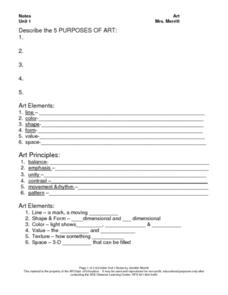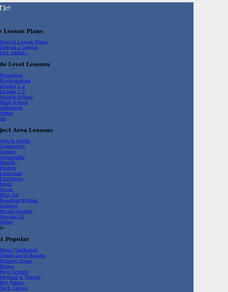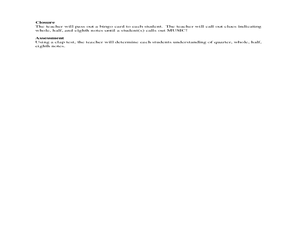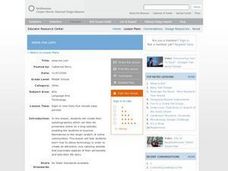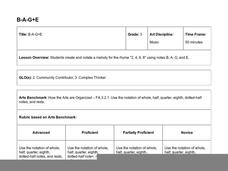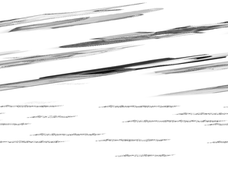Curated OER
Musical Note Value
Students will identify each symbol by sight stating the value of each. They will use cardboard notes to who what they have learned so far about the note values creating 4 and 6 count phrases.
Curated OER
Notes Unit 1: Art Fundamentals
Here is a guide for your middle schoolers to use while you are providing a lecture on the basics of art. They use this worksheet to aid them as they take notes on the purpose of art, art elements, properties of art, and art principles....
Curated OER
SIGHT READING RHYTHM PATTERNS
The perception of rhythms by reading and the ability to auditorily discriminate these rhythm patterns by listening to them performed by the teacher is practiced here. your students will work to create an eight-beat long rhythm pattern.
Curated OER
You've Got Rhythm
Students study the rhythm value of a half note, quarter note, whole note, and eighth note. They stamp a rhythm pattern and create a clay animation which demonstrates note value.
Curated OER
Lesson Exchange: Musical Mathematics (other, Music)
Students explain note values and relationships, especially dotted rhythms and tied notes by giving them a visual, hands on representation
MakingMusicFun.net
It All Adds Up | Free Music Rhythm Worksheet IV
In this rhythmic values worksheet, students explore musical notes and their values. Students add the note values together to get a total number of beats for the two notes in each of the 30 sets.
Curated OER
It All Adds Up | Free Music Rhythm Worksheet I
For this music worksheet, students add up three columns with the totals for the whole, half, and quarter notes. They also add up the values of each pair of notes and then calculate the column totals. No hints or examples are provided;...
Curated OER
Orchestra: Focus on Rhythm and Arranging
High school orchestra is a great place to play music, like The Star Spangled Banner. Upper graders create new rhythms to the old song and perform them with the class. They rehearse their updated versions of the song using their...
Curated OER
Rhythm, Math, Rhythm
Students play instruments in math class to learn the interconnectedness between math and music. In this math lesson, students subdivide a piece of music, clapping rhythms and charting rhythm patterns in the song. A guided discussion...
Curated OER
Rhythm In Motion
Sixth graders work independently and with a partner to demonstrate proficiency of steady beat, meter and basic note values while creating written rhythmic patterns for class performance. State and National Standards are addressed.
Curated OER
Math, Fractions, and Music
Students discover the relationship between musical rhythms and fractions. They add musical notes together to produce fractions and create addition and subtraction problems with musical notes. Students complete worksheets and create their...
Curated OER
Basketball Notes
Students add the value of various musical notes to win a chance to shoot a basketball. They compete in teams and consider the values of quarter, half and whole notes to complete related math problems.
MakingMusicFun.net
It All Adds Up | Free Music Rhythm Worksheet III
In this music addition learning exercise, students add the musical notes in each equation to find the correct rhythm beats.
Curated OER
Music Box Identification
Fourth graders draw and label music notes and rests. In this music box lesson students use staff paper to draw the notes required. The students give the value of each note or rest.
Curated OER
Reading Basic Music Notes
First graders develop skills in reading music notes. In this reading music lesson plan, 1st graders clap and chant rhythm patterns and learn music vocabulary. Students also match patterns by listening to the teacher perform the pattern.
Curated OER
Visualization of Rhythms in 4/4
First graders investigate musical notes. In this music lesson, 1st graders discuss the values of each note by counting the beats accordingly.
Curated OER
Note Bowling
Students practice recognition of different music notes and their values and work on throwing cues, scoring, and addition.
Fun Music Company
Compound Time
To demonstrate their understanding of simple and compound time signatures, young musicians complete a chart by drawing quarter or dotted quarter notes equal in value to the note groups shown.
Curated OER
Spooky Notes
Second graders move to, sing, compose, and interpret various musical techniques through the use of "America", Tchaikovsky's "Waltz of the Flowers", and a song called "Skin and Bones". Emphasis is placed upon identifying names and values...
Curated OER
www.Me.Com
Create a graphic autobiography integrating images and text. Working within the structure of the programs Comic Life and Photoshop, pupils integrate the Principles of Design. They focus on balance, rhythm, proportion, and text structure....
Hawaiʻi State Department of Education
B-A-G+E
Budding musicians discuss rhythmic notation and melody as they play a bar instrument or recorder. They use the notes B, A, G, and E to play a simple melody, and then they use those same four notes to turn a poem into a song. They...
Curated OER
Dance is B.E.S.T.: Time
Students demonstrate dance activities and rhythm activities to whole, half, quarter, and eighth notes. They clap and move to notes individually and in 16 count metric phrases. As they create different 16 count metric phrases and...
Curated OER
A Round and A Round
Students practice singing rounds in daily warm-ups for 2 weeks prior to beginning this composition lesson plan. Students incorporate movement to the rhythm of each syllable, discuss syllables of words and their relationship to note...
Curated OER
Abstract Planes in Paper Sculpture
High schoolers create maquettes of abstract sculptures utilizing the elements of art; line, shape, value, color, space and texture and the principles of design; balance, emphasis, contrast, rhythm and movement, pattern and unity. These...

